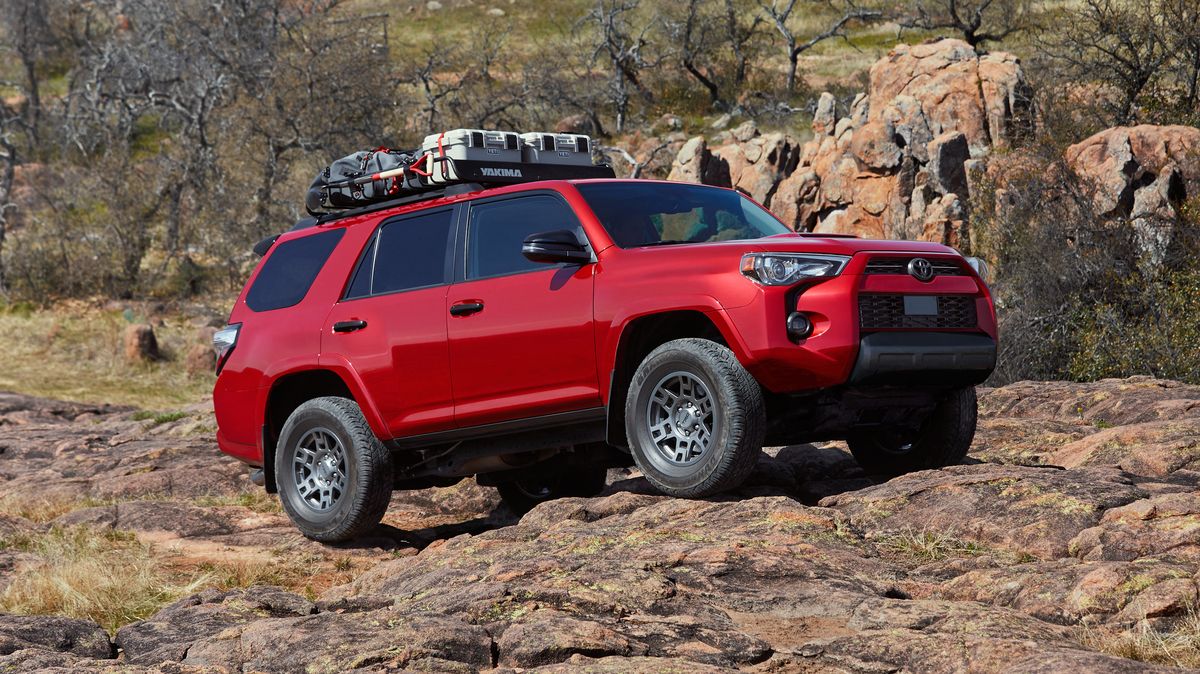Clambering behind the 2024 Toyota 4Runner‘s large steering wheel feels like a throwback to one of those Presidential fitness exams you took in grade school. The move is a blend of the Sit and Reach and Partial Curl-Up, in that you instinctively grab at the wheel’s rim with one hand, hold the door with the other, and heave yourself up to the high floor, shooting your legs straight out ahead of you as your butt hits the seat.
Engine, Transmission, and Performance
Every 4Runner is motivated by a 270-hp 4.0-liter V-6 paired with a five-speed automatic transmission. Available with rear-wheel drive and either full- or part-time four-wheel-drive systems, the outdated powertrain provides unremarkable acceleration, with the last version we tested taking 7.7 seconds to hit 60 mph. The automatic’s lethargic responses don’t optimize the engine’s uneven behavior, and downshifts often require heavy right-foot inputs to spur the 4Runner ahead.
Still, the 2024 Toyota 4Runner manages to feel more composed on pavement than the more unwieldy Wrangler. Our time behind the wheel of the off-road-oriented model showed off the SUV’s notable ground clearance, and its body-on-frame construction was supported by a soft suspension that absorbed a variety of terrain reasonably well. The 4Runner’s steering is lightly weighted and imprecise, and while those traits betray any sense of sportiness, they’re fine for crawling along trails and around parking lots.
Aged though the Toyota feels in action, its performance is right in the mix with its more modern competitors, including the V-6 Dodge Durango. And the Toyota’s rugged frame and torque-rich engine give it a leg up in towing; its 5000-pound capacity beats the Ford Edge and Wrangler, while falling short of the more powerful Durango’s 8700-pound capability.
Fuel Economy and Real-World MPG
The 2024 Toyota 4Runner‘s powertrain combinations show their age at the pump, with every model rated at a lowly 16 mpg in the city and 19 mpg on the highway. For comparison, the automatic, V-6-powered Wrangler has much better estimates of up to 19 mpg city and 24 highway. The last 4Runner we tested on our 75-mph highway fuel-economy route, which is part of our extensive testing regimen, did exceed expectations by returning 22 mpg. For more information about the 4Runner’s fuel economy, visit the EPA’s website.
Interior, Comfort, and Cargo
The interior of the 2024 Toyota 4Runner is not what you’d call state-of-the-art, with switchgear that could have come from the latter years of the last millennium. Lackluster materials and styling aside, it manages to comfortably fit humans front and rear in spite of its back-of-the-class interior measurements. We haven’t tested the optional third row, but we suspect that it’s best for children. A flexible cargo area and several large, deep cubbies in the front row mean that the 4Runner is as versatile a hauler as it is a rock-crawler.
Just don’t try to heave anything into the cargo hold unless you have a chiropractor on call—its floor is uncomfortably high off the ground. The two-row models that we tested had an optional pull-out cargo deck designed to make loading and unloading heavy items—up to 440 pounds—a little easier. It can also double as a tailgate for seating. This provides a flat load floor when the second-row seats are folded, but also robs the cargo hold of several inches of height. Even so, we fit an impressive 14 carry-ons behind the second row.
Infotainment and Connectivity
Every 2024 Toyota 4Runner features an average-sized 8.0-inch touchscreen infotainment system. The interface includes a set of physical buttons as well as rotary volume and tuning knobs. The system comes standard with wired Apple CarPlay and Android Auto, a SiriusXM trial subscription, and a subscription-based Wi-Fi hotspot. A built-in navigation system and a 15-speaker JBL audio system are available upgrades.
Safety and Driver-Assistance Features
Every model has a host of standard driver-assistance technology that includes automatic high-beam headlamps, blind-spot monitoring, rear cross-traffic alert, and more. For more information about the 4Runner’s crash-test results, visit the National Highway Traffic Safety Administration (NHTSA) and Insurance Institute for Highway Safety (IIHS) websites. Key safety features include:
- Standard forward-collision warning and automated emergency braking
- Standard lane-departure warning and lane-keeping assist
- Standard adaptive cruise control
Photos

Specifications
2022 Toyota 4Runner TRD Pro
Vehicle Type: front-engine, rear/4-wheel-drive, 5-passenger, 4-door wagon
PRICE
Base/As Tested: $53,635/$55,003
Options: sliding cargo deck, $350; running boards, $345; cargo cover, $179; TRD floor mats, $169; hood protector, $165; blackout emblem overlays, $160
ENGINE
DOHC 24-valve V-6, aluminum block and heads, port fuel injection
Displacement: 241 in3, 2956 cm3
Power: 270 hp @ 5600 rpm
Torque: 278 lb-ft @ 4400 rpm
TRANSMISSION
5-speed automatic
CHASSIS
Suspension, F/R: control arms/live axle
Brakes, F/R: 13.3-in vented disc/12.3-in vented disc
Tires: Nitto Terra Grappler All-Terrain
P265/70R-17 113S M+S
DIMENSIONS
Wheelbase: 109.8 in
Length: 191.3 in
Width: 75.8 in
Height: 71.5 in
Passenger Volume: 96 ft3
Cargo Volume: 46 ft3
Curb Weight: 4800 lb
C/D TEST RESULTS
60 mph: 7.7 sec
1/4-Mile: 16.0 sec @ 86 mph
100 mph: 23.8 sec
Results above omit 1-ft rollout of 0.3 sec.
Rolling Start, 5–60 mph: 8.1 sec
Top Gear, 30–50 mph: 4.2 sec
Top Gear, 50–70 mph: 5.6 sec
Top Speed (gov): 113 mph
Braking, 70–0 mph: 192 ft
C/D FUEL ECONOMY
Observed: 15 mpg
75-mph Highway Driving: 17 mpg
Highway Range: 390 mi
EPA FUEL ECONOMY
Combined/City/Highway: 17/16/19 mpg


